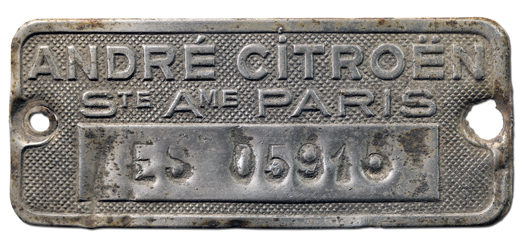Solid infomation!
The sources
The main source of information in the book is collected directly from the old handwritten factory ledgers, the so-called Mains Courantes, where every single car which left the Quai de Javel factory is listed. The author spent more than 200 hours of researching in these holy books – and at least as much time was spent on the subsequent processing. Other sources such as registers and documents from both Citroën and others as well as observations of cars have completed the enormeous amount of information provided by the book.
Identifying the cars
You can use the book as reference if you want to identify any Traction: The many tables representing all the series of production allow you to determine the period of production, in most cases within a month, and see the corresponding numbers. As in the old register books from Quai de Javel the key is the factory numbers – numbers that were always associated with great mystery, and never of any use once the car had left the factory. This is now the past: The factory numbers identifies and dates the cars with far more accuracy than the cars’ serial numbers. The serial numbers were all we had, but in many cases the serial numbers do not even provide information about the year of production.
General infomation
Even if you are not dealing with a specific car you can get lots of valuable general information. You can follow the production of any model and get an impression of the production rate in any period of time, the firsts and the lasts, and learn about the general evolution. The tables of production series are organised (almost) chronolgically, going through the entire production 1934-57. Even if non-commercialised cars (prototypes, cars for exhibitions etc.) are not always registered you will find hard facts about models as rare as the 22CV V8s, the Coupe de Villes, 7S/11ALs, 11AM and all the others.
The structure of the book
There are two main parts in the book. Part one contains an introduction to the (many) different variants of the Traction: all the models and body styles. The four principal numbers of the cars are introduced and described in detail: Their purpose, where to find them, and what they can tell you about a car. The system of factory numbers and how they were assigned to the cars is thoroughly explained.
The second part are the tables of production along with observations, comments and photos – mostly factory photos; some known and some previously unpublished. Even if it was never the goal to publish a book about the evolution of the Traction, most of the major steps can be found here – changes such as the rack and pinion steering, appearance of new engines, rear boot and more – always described in the exact series of production where they were introduced.
A third section is the appendices with index to factory number, production figures and much more.
We regret that the book is only available in English – publishing in both English and French has (so far) not been possible due to financial limits. Anyway, numbers are numbers – and some people say that Google is your friend…
|



